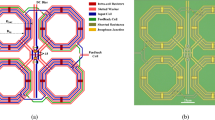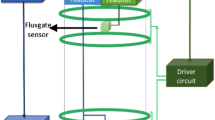Abstract
The possibility of improving dc SQUID performance by damping the input circuit resonances caused by parasitic capacitances is studied experimentally. A high-quality dc SQUID was coupled to a first-order axial gradiometer built for neuromagnetic research, and a resistor-capacitor shunt was connected in parallel with the input coil of the SQUID. Ten differentRC shunts were studied with the SQUID operating in a flux-locked loop, carefully shielded against external disturbances. It was found that increasing the shunt resistance resulted in smoother flux-voltage characteristics and smaller noise. At best, the minimum obtainable equivalent flux noise level was one-fourth that for the unshunted SQUID. The noise level is a function of the shunt resistanceR s only, except for shunt capacitance values bringing the low-frequency resonance of the input coil close to the flux modulation frequency. At a constant bias current level, where the amplitude of the flux-voltage characteristics is at maximum, the equivalent flux noise varies asR /−0.7 s . The results agree reasonably well with recently published predictions based on numerical simulations where the whole input circuit with parasitic capacitances was taken into account.
Similar content being viewed by others
References
J. Clarke,Physica 126B, 441 (1984).
R. Hari and R. J. Ilmoniemi,CRC Crit. Rev. Biomed. Eng. 14(2), 93 (1986).
S. J. Williamson and L. Kaufman,J. Magn. Magn. Mater. 22, 129 (1981).
C. D. Tesche,J. Low Temp. Phys. 47, 385 (1982).
M. Gershenson, R. Hastings, R. Schneider, M. Sweeny, and E. Sorensen,IEEE Trans. Magn. MAG-19, 2058 (1983).
K. Enpuku, K. Sueoka, K. Yoshida, and F. Irie,J. Appl Phys. 57(5), 1691 (1985).
D. Drung and W. Jutzi, inSQUID'85—Superconducting Quantum Interference Devices and Their Applications, H. D. Hahlbohm and H. Lübbig, eds. (de Gruyter, Berlin, 1985), p. 807.
H. Seppä and T. Ryhähen, in Proceedings of the 1986 Applied Superconductivity Conference,IEEE Trans. Magn., submitted for publication (1987).
C. Hilbert and J. Clarke,J. Low Temp. Phys. 61, 237 (1985).
P. Carelli and V. Foglietti,IEEE Trans. Magn. MAG-19, 299 (1983).
P. Carelli and V. Foglietti,IEEE Trans. Magn. MAG-21, 424 (1985).
B. Muhlfelder, J. A. Beall, M. W. Cromar, R. H. Ono, and W. W. Johnson,IEEE Trans. Magn. MAG-21, 427 (1985).
C. D. Tesche and J. Clarke,J. Low Temp. Phys. 29, 301 (1977).
V. J. de Waal, P. Schrijner, and R. Llurba,J. Low Temp. Phys. 54, 215 (1984).
V. J. de Waal, T. M. Klapwijk, and P. van den Hamer,J. Low Temp. Phys. 53, 287 (1983).
C. M. Pegrum, D. Hutson, G. B. Donaldson, and A. Tugwell,IEEE Trans. Magn. MAG-21, 1036 (1985).
B. Muhlfelder, J. A. Beall, M. W. Cromar, and R. H. Ono,Appl. Phys. Lett. 49(17), 1118 (1986).
R. S. Germain, M. L. Roukes, M. R. Freeman, R. C. Richardson, and M. B. Ketchen, inProceedings of the 17th International Conference on Low Temperature Physics LT-17, U. Eckern, A. Schmid, W. Weber, and H. Wühl eds. (Elsevier, Amsterdam, 1984), p. 203.
C. D. Tesche,Appl. Phys. Lett. 41(5), 490 (1982).
C. D. Tesche,IEEE Trans. Magn. MAG-19, 458 (1983).
J. M. Martinis and J. Clarke,J. Low Temp. Phys. 61, 227 (1985).
A. I. Ahonen, J. K. Hällström, M. J. Kajola, J. E. Knuutila, C. D. Tesche, and V. A. Vilkman, inProceedings of the 11th International Cryogenic Engineering Conference ICEC11, G. Klipping and I. Klipping, eds. (Butterworth, Guildford, 1986), p. 820.
J. Knuutila, A. Ahonen, J. Hällström, M. Kajola, O. V. Lounasmaa, V. Vilkman, and C. Tesche, to be published (1987).
C. D. Tesche, K. H. Brown, A. C. Callegari, M. M. Chen, J. H. Greiner, H. C. Jones, M. B. Ketchen, K. K. Kim, A. W. Kleinsasser, H. A. Notarys, G. Proto, R. H. Wang, and T. Yogi,IEEE Trans. Magn. MAG-21, 1032 (1985).
V. O. Kelhä, J. M. Pukki, R. S. Peltonen, A. A. Penttinen, R. J. Ilmoniemi, and J. J. Heino,IEEE Trans. Magn. MAG-18, 260 (1982).
P. D. Welch,IEEE Trans. Audio Electroacoust. AU-15, 70 (1967).
J. S. Bendat and A. G. Piersol,Random Data: Analysis and Measurement Procedures (Wiley, New York, 1971), Chapter 9.6.
M. R. Beasley, D. D'Humieres, and B. A. Huberman,Phys. Rev. Lett. 50, 1328 (1983).
Author information
Authors and Affiliations
Rights and permissions
About this article
Cite this article
Knuutila, J., Ahonen, A. & Tesche, C. Effects on DC SQUID characteristics of damping of input coil resonances. J Low Temp Phys 68, 269–284 (1987). https://doi.org/10.1007/BF00683902
Received:
Issue Date:
DOI: https://doi.org/10.1007/BF00683902




